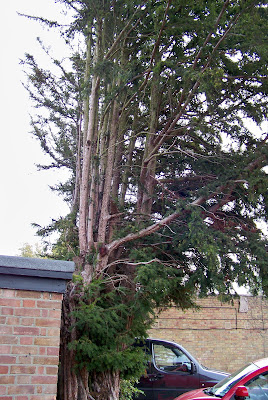
 I got the belly patch glued last night using Resintite. The patch was held in place with masking tape to stop it slipping and then bound with rubber strapping.
I got the belly patch glued last night using Resintite. The patch was held in place with masking tape to stop it slipping and then bound with rubber strapping.To stop the glue filling the hole of the small knot I stuffed a bit of twisted paper towel into it.
By the way, it took 3 tries to get the patch the right shape and grain alignment, first bit was too small, second bit was perfect until I realised I got the grain edge on... damn.
It was a relief to see it looked good this morning. A quick clean up with my big bastard file revealed the result. The small hole cleaned out easily by running a drill up though it and then cleaning it out with a file.
If you compare the result with the pencil lines I drew on the stave you will see I didn't take off as much wood as I had been contemplating, this is mainly because a thinner patch is slightly flexible and will conform to the shape of the cut out, and also the knot was very clean and solid inside.
It looks slightly odd with the line of the patch cutting through the knot, but there wasn't really any other way to do it, short of slicing off half the width of the bow which would have been a bit drastic and would have spoilt the back.
There comes a point where you think, if I'm going to cut away every discontinuity or imperfection I might as well laminate a stave.
The patch hopefully will do the job of bulking up the heart wood in that area and preventing any movement around the knot whilst retaining some of the knot which shows the character and keeping the integrity of the back.
I may be able to reduce the sapwood a little during tillering rather than removing heartwood as I don't want to end up back at square one with almost all sapwood and the knot showing on the belly.
You can see I decided to patch first and then plug the small knot, this was more about impatience than aesthetics or mechanics, but I do think it adds to the integrity of the piece. (Hmmm sounding a bit like an art critic there. "The rigid lines of the patch juxtaposed with the roundness of the knot symbolising man's struggle against nature" ;) )
I'll peg the small hole today, but I won't flex it on the tiller until it's had a few days for the glue to really cure.
I should add that the remaining black area in the knot will be excavated and filled later.






































